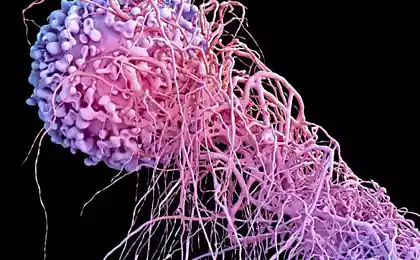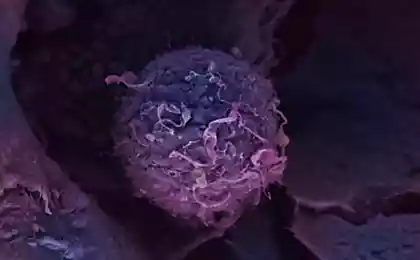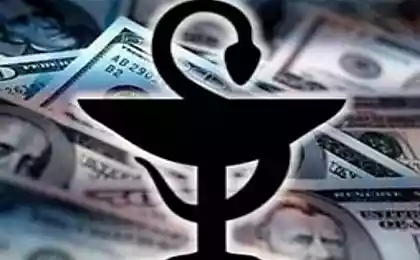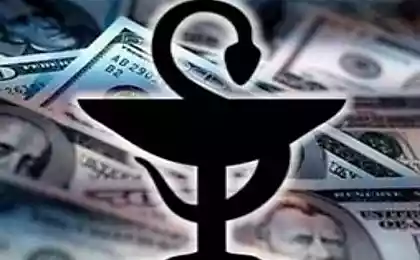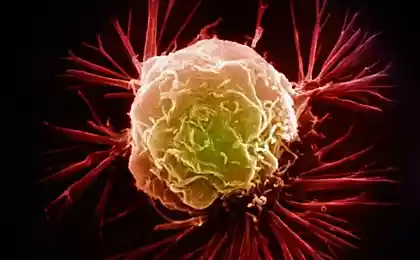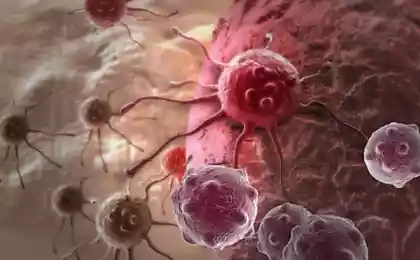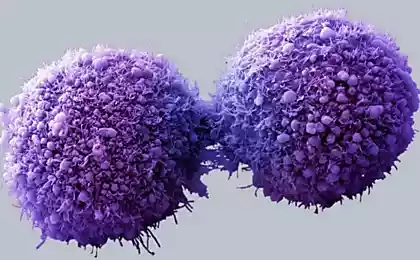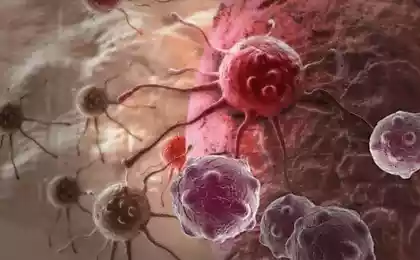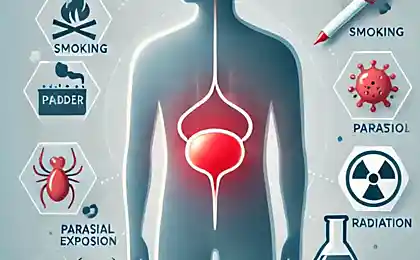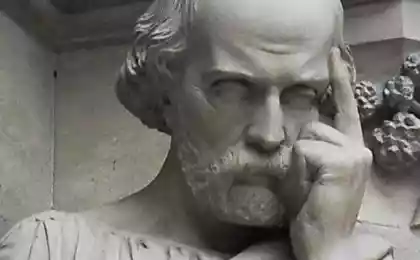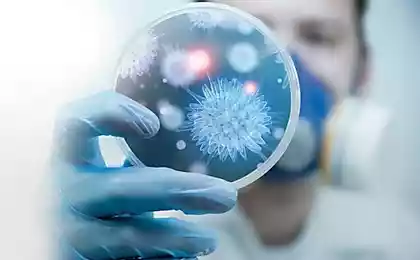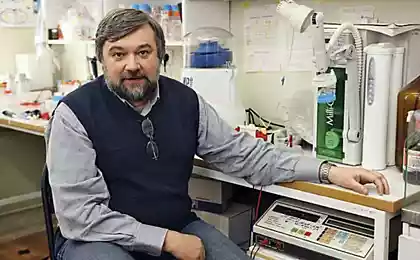428
The True Causes of Cancer
In the early 70s of the last century, a new psychoanalytic trend appeared in Italy - micropsychoanalysis, which is a continuation of the psychoanalysis of Sigmund Freud.
In psychoanalysis, the role of the influence of the unconscious on the consciousness of the subject is investigated. This can be represented in the form of a puppet (consciousness), which reveals (by psychoanalysis, of course) its dependence on the desires of the puppeteer (unconscious).
And if before the doll was sure that “she is on her own”, then now she realizes her subordination and dependence, she learns to “live with it” and is forced to find a common language with her puppeteer.
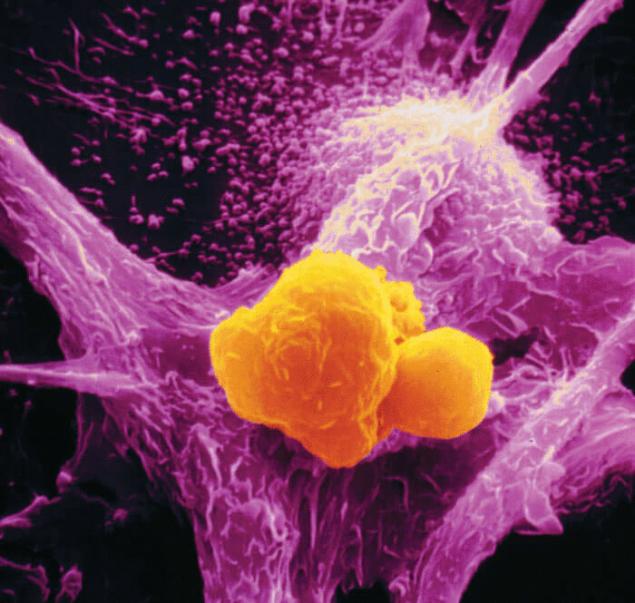
In psychoanalysis, the unconscious is an agent of influence that translates its desires into consciousness (for example, sexual desires). This can be compared to watching TV ads: either you fall under the influence of advertising, or you ignore the attempts to influence it, but you are unable to influence advertising. The subconscious is always an agent of influence, and consciousness is the recipient, the receiver, on which this influence is exerted.
Micropsychoanalysis carefully preserves the Freudian paradigm, but at the same time “deepens into the topic”: if the subconscious determines the content of consciousness, then who determines the content of our subconscious?
Micropsychoanalysis places a comma where psychoanalysis has put an end. Yes, the puppet moves because the puppeteer pulls the strings, but what then moves the puppeteer?
If we are driven by the subconscious mind, doesn’t that mean that our subconscious mind is also driven by someone?
And while psychoanalysis seeks an explanation for actions performed in the continuum of consciousness, micropsychoanalysis studies actions performed in the continuum of the unconscious. As a result, the true causes of human actions are found not in the subconscious of the analyzed person, but in his pre-consciousness, in his pre-psychic life.
1. Micropsychoanalytic interpretation of embryonic experience
From the perspective of micropsychoanalysis, the nature of cancer originates in biological attempts at procreation. By interpreting biological phenomena (how psychoanalysis interprets dreams and reservations), micropsychoanalysis reveals a complete identity in the patterns of development of the embryo (after fertilization) and the cancer cell.
Or, in other words, a cancer cell develops according to the same laws as an embryo in the womb. It is important to emphasize that there is no symbolism or imagery in micropsychoanalytic interpretations (as we have come to expect from psychological theories). It's not a metaphor, it's literally. And now we will learn more about this amazing statement.
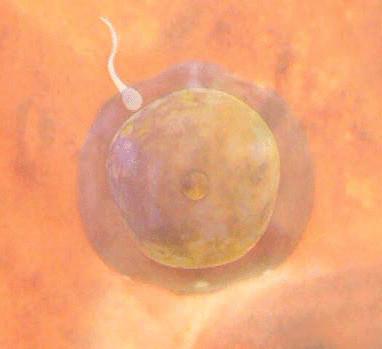
Figure 1. The sperm enters the egg.
At the time of penetration of the sperm on the egg runs "electric shivering", it experiences a physico-chemical revolution, after which the germ cell becomes impregnable to other sperm. Haploid sets of female and male chromosomes (gametes) merge, and the first diploid egg is formed. It begins to move towards the uterus (due to muscle contractions of the tube and movements of the epithelium villi). On the way to the uterus, the egg begins to break. 30 hours later, it has 2 cells, another twenty hours, 4 cells, and 8 cells at the sixtieth hour.
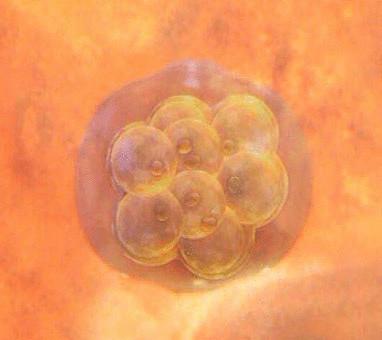
Figure 2. Morula.
On the fourth day, the egg, now made up of 16 cells, forms a small “tummy berry” called a morula. Morula makes the transition from the tube to the uterus and, floating freely in it, continues to divide. On the fifth day, 150 germ cells form a blastocyst (blastos - sprout, embryo, and cystos - cyst, bladder), which contains:
1. Embryoblast (cell mass from which the embryo is formed),
2. Trophoblast (a single cell layer surrounding the germ kidney).
3. Blastocele or blastocyte cavity (primary intestinal cavity).
Blastocyst is the stage of development of mammals (animals and humans) in the process of crushing a fertilized egg. It contains a germ nodule from which the embryo and its shells develop.
The tranquility of these first days is deceptive. During an odyssey, a human egg is at risk of dying nine times out of ten. The causes of this death are still poorly understood, but there is no doubt that “mechanisms of destruction” come into force when the preservation of an individual is threatened by cellular pathology (related primarily to genetic disorders). This phenomenon proves that:
The attempt at individual destruction often hides the attempt at collective preservation.
In other words, if this organism develops into an adult, it will be a “transmitter” for other individuals of its cellular pathology. In order to avoid this, the body dies at the earliest stages of its development (the first week of pregnancy, as mentioned above), if it has a cellular pathology. This process can be accidental (due to cellular pathology, unviable), and intentional (failed face control, if you can say so).

Figure 3. blastocyst
Around the seventh day, the process of implanting an egg into the uterus begins. For 72 days, while it lasts, the blastocyst desperately tries to “build a nest” in the uterine wall. This is because, unlike reptiles, birds and some mammals (echidna eggs, platypus), the human egg lacks a large supply of nutrients. It begins to feel their lack and survives only if it attaches to the maternal tissue. Thus, on the eighth day
The human blastocyst is a cannibal.
Egg cells wrapped in a blastocyst multiply and form a trophoblast in which chorionic villi are formed. The villi penetrate between the walls of the uterus and destroy them through alkaline enzymolysis (the remains of which are devoured by them). When this mode of nutrition is also insufficient, trophoblast begins its placental specialization: villous peripheral cells lose their membranes and form a protoplasmic layer (syncytitrophoblast), dotted with nuclei, which differentiates peripheral microvilli (brushed edges). They are screwed into the mother tissue so that the compound site turns into bloody lakes. On the twelfth day:
The embryo washes in the mother’s blood and feeds on it, while she tries to heal the wound he inflicted on her.
The ineradicable mortal hatred of some analysed persons towards their mothers is a fixation on those days. With the help of micropsychoanalysis, it was found that an adult person keeps in the depths of his unconscious the memory of how he devours his mother and revels in her blood. In order to survive this bloody embryonic epic, a person does not skimp on fiction and tries to devour his fellow tribesmen and/or figures replacing them. Not from the inside, but from the outside. Not in the role of “endoparasite” (endo, that is, from the inside), but in the role of “ectoparasite” (ecto, from the outside). This also explains why in some subjects (without distinction of sex) menstrual discharge is an insatiable need, which they “revel in” both figuratively and literally.
From an immunological point of view, the embryo is a foreign body, starting from the very first attempts to implant into the wall of the uterus. The biological orders of his paternal genes incessantly excite his mother’s immunocyte system, which responds with a blow to the blow, and produces antibodies attached to the trophoblast. Or, put another way, the mother also resorts to cannibalistic means to deter the antigenic attacks of the embryo. Consequently:
A mother’s first reaction to her child is rejection.
According to the principles of immunology during pregnancy (we are talking about experiments in the laboratories of Inserm and Recklin’s group in Boston), the embryo should be completely eliminated. Then why does he manage to survive?
This is due to the sophistication of protective mechanisms in the embryo: trophoblast produces immunoretaining secretion, inhibiting (slowing down, depressing) the production of maternal antibodies and a toxic substance that paralyzes phagocytosis (this is the immune response of the body, “eating” foreign cells). Thus:
The development of a human fertilized egg can be identified with the development of a malignant tumor.
The fruit devours its mother. That's the only way he can survive. With the help of the placenta (an organ formed by the villi of the outer lining of the embryo and the mucous membrane of the uterus, which performs the functions of digestion, breathing and excretion), the fetus seems to manipulate the physiology of the mother in its own interests. The placenta “voices” the mother’s needs with the help of hormones. For example, it requires the mother’s body to thin its blood (to make it more fluid). This leads to an increase in blood volume, and it can reach 40%. Through the placenta, with the help of pinocytosis (a variant of phagocytosis), the fetus ensures the capture of complex proteins, fats and certain antibodies, and causes them to penetrate into the cell. Taking away nutrients from the mother, the fetus throws “digested residues” into her body, so that vomiting from the mother – as a desire to get rid of the uterine process – can be understood both symbolically and literally.
2. Traditional theories of cancer
In science, there are several theories about the causes of cancer: these are carcinogenic substances, a viral cause and “bad” heredity.
These reasons are supported by a significant amount of experimental data, which, however, does not help to fight cancer. Science can make a probabilistic prediction: for example, to predict the percentage of cancer in a particular group of people. And that's all she can do. Even by observing a particular group of people, it is impossible to predict who in this group will get cancer (Zaridze). We can only make a general prediction.
Like what? For example, the hepatitis B and C virus greatly increases the risk of liver cancer. That's the prediction. High risk. It is impossible to determine whether or not it will lead to disease (because it depends on many external and internal factors). The cause of cancer is unknown, and therefore can only be assumed. The risk is higher if you smoke. The risk is higher if the environment is poor. The risk is higher if you have a mobile phone. And so on and so on and so forth. The cause is unknown. No cure. And, therefore, cancer is still considered fatal and incurable diseases. Despite all the advances in medicine and genetic engineering.
Today I offer you a hypothesis about the cause of cancer, which lies in line with micropsychoanalytic ideas about the person. And I must say right away that there is no promise, no hope in this hypothesis. It's a hypothesis, that's all. Even if it turns out to be the most plausible of all existing, it will not be able to cure. She's not promising new drugs. And you must know that. Before you get acquainted with this hypothesis. Only then do you get on the road. There is a lot of knowledge and a lot of sorrow. Are you ready for this?
3. Cancer as a process of re-actualization of embryonic experience
In the micropsychoanalytic sense of these words, the process of our birth into white light is identical with cancer. And there's nothing dramatic about it. There is nothing dramatic about the fact that out of 300,000 sperm, only one of them achieves the desired goal. And that was more of an accident. In theory, several fractions of sperm (one man) can fertilize all women on the planet. But it's only theoretical. And for almost one attempt to conceive, nature sacrifices tens of billions of potential lives. Conversely, it also rejects them (face control) in nine cases out of ten, as mentioned above. At the very beginning of his journey, even before the implantation of the egg into the uterus.
Micropsychoanalysis proves that deep in our unconscious we remember very well how we managed to survive. We devoured our mother. We drank her blood, we forcibly took away her nutrients, poisoning her “in exchange” with decay products. This is what nature intended. That’s how – and only so! – we survived. Fixation on these moments (it can be caused by various reasons, for example, intense attempts to reject the fetus on the part of the mother, lack of nutrients in her body, toxicity, high levels of antibodies that threaten the “life” of the fetus, and the like), as Silvio Fanti showed, can haunt a person throughout his life. This experience is fixed in the subconscious, and its actualization and degree of reactivity (for example, in the case of menstrual perversions, cannibalism), depends on the severity of the drama that a person experienced during his womb. The same experience is fixed at the cellular level, or, in other words, the cells "remember" how to survive in a difficult situation for them. And, under certain circumstances, this cellular experience can also (as in the case of the subconscious) be actualized.
You know what this is about? If, for whatever reason, the cell decides that this experience of uterine survival is necessary for it to survive in the present tense, what does it do?
First, it changes its “behavior” and possibly its structure (atypical cell). This process does not pass unnoticed by the body: our main defenders, T-lymphocytes, find and destroy atypical cells with terrible force. This ability of the body to reject any foreign cells is so great that when transplanting organs (heart, kidneys), the patient has to give a lot of drugs that suppress the immune system. Otherwise, the implanted (foreign) organ will be rejected. In the case of a cell that has changed its behavior, this does not happen. Why? Because she's defending herself. The cell “remembers” that it is obliged to resist phagocytosis, otherwise it will simply “eat” (this is a reaction of rejection of the fetus by the mother, as you remember). That's second. And finally, the atypical cell begins to divide uncontrollably, since it “knows” that it must do this for the effective survival of the fetus.
Thus, in certain situations, the cell (or cell colony) actualizes its (identical to the formation of a cancerous tumor) experience of fetal survival in the womb. And he's trying (Fanty's favorite word) to repeat it. Despite the seeming absurdity of this attempt, it is not without meaning: the previous experience of survival was successful (the fetus successfully survived, developed and was born into the world), and, therefore, the desire (or need) of the cell to repeat it is quite natural. Similarly, a person’s subconscious mind reacts to interactions with the world: it tends to repeat the experience (if successful) or avoid it (if unsuccessful). For example, from a single success (winning a sporting event), a person can make a “conclusion” (this should be understood in a figurative sense, since the decision made is irrational and dictated by the subconscious) that he was born for this sport (and the word “born”, and it is very often used in such cases, perfectly confirms my assumptions about a cellular attempt to actualize my experience). Just like a person who has failed (lost in a sports competition) loses all interest in this activity and does not try to repeat it again. "It's not mine," he says in such cases. And this reflects very accurately his "biological" knowledge that there is no second attempt, and there is no chance for the second, third, and everyone else. Once the sperm enters the egg, it becomes inaccessible to other sperm, remember? To be anywhere except the first is to be destroyed.
Unfortunately, a single survival experience can be fatal if the body tries to replicate it. For example, drugs: I told you about this in detail in the material about the bodily unconscious. Based on the principle of “seeking the pleasant – avoiding the unpleasant”, the bodily unconscious again and again presses the heroin pedal, receiving another portion of pleasure.
Pleasure is life. Unpleasant is death. Thus, giving up drugs is interpreted by the bodily unconscious as a threat to survival, and taking drugs as a life-giving principle. As a result of this obvious error, the body is rapidly destroyed. The unconscious continues to interpret this strategy as the most effective for survival. Contrary to common sense and objective state of affairs.
From a psychoanalytic point of view (I emphasize this in psychoanalysis, not in micropsychoanalysis), the rapid division of cancer cells seems to signal an attempt to return to childhood. In other words, cancer is the result of an unconscious desire to return to childhood. Wanting to escape from the problems of adulthood and hide in the past, a person provokes cancer.
This theory has no practical application, since a cancerous tumor in this case is nothing more than a psychodiagnostic symptom indicating the psychoanalyst to the client’s problem. In addition, such an interpretation cannot explain why these cells become virtually immune to the body’s immune system.
From the perspective of micropsychoanalysis, the cause of cancer is more biological than mental. This should come as no surprise, since the fundamental tenets of micropsychoanalysis are based largely on research in physics, biology, and genetics. Artifacts of the unconscious (such as repression or the urge to die) in micropsychoanalysis are not so much causal as investigative phenomena. In other words, the actions of a person (by which we usually tend to find some kind of “cause” in the unconscious), from a micropsychoanalytic standpoint, are a consequence of the effect, but not a consequence of the cause. The true causes of “causes” lie much deeper: in the specific features of the organization of the synapse or cell, in the biological void (one of the main points in micropsychoanalysis), and in the elementary energy with which this void is filled.
But back to our atypical cell, the behavior of which can be interpreted as an attempt at survival. What causes a cell to act contrary to the well-established mechanisms of cellular sociology? Hunger, in the literal sense of the word. Nutrient deficiencies. For some time, the fundamental principles of cellular organization can keep the cell from doing something “unlawful” (as the law forbids stealing without considering how much you want to eat), but if hunger gets worse, the cell “breaks” and becomes unmanageable. At the same time, she “knows” that this cannot be done, and therefore she begins to defend herself against the attacks of the “hostile” organism (which seeks to destroy her). And when this protection is acquired, and the cell feels completely safe, it “sucks” to the organ (most likely the first one to come across), after which it begins to multiply uncontrollably (again, for effective survival). The result is cancer. At the same time, it is very important to note that the effect of carcinogens (or other “harmful” substances) on this process is much less than is commonly believed. The presence of these substances in the body makes it difficult for the cell to nourish, and thus can provoke the cell to re-actualize its embryonic experience. That is, the influence of such “harmful” substances is passive, not aggressive, as is commonly believed. To illustrate this argument, I will give a simple example: if there is an insurmountable chasm between a person and a self-defeating tablecloth, and this causes cancer, then it is difficult to call an insurmountable chasm the cause of cancer, since this chasm is neutral to human hunger. In this case, the true cause of cancer is hunger, which has brought the cell into a state of repeated embryonic actualization.
From this point of view, it is not difficult to detect another property of a cancer cell: compared to its “normal” counterparts, it has a more primitive organization. Why this happens is not hard to guess: a primitive organism requires less energy, and therefore easier to maintain its vitality. Figuratively speaking, the cell no longer wastes its energy on stupidities like responsibility or justice. She has “one task, not to get to the cemetery”, in the words of Filatov. She lives to eat. That is her mission, her purpose in life. If desired, an analogue of such behavior can be found in a person: in a state of chronic hunger, his behavior (and thinking) is so primitive that everything human is lost in him. This is well known to prisoners of concentration camps (Victor Frankl) and prisoners of Stalin’s gulags (read Varlam Shalamov). During the famine in Ukraine in the thirties, parents ate their children, as evidenced by archival documents of the time.
The second reason an atypical cell regresses toward a more primitive organization is that it is easier for a primitive to reproduce its own kind. This means that an atypical cell (as it regresses into a more primitive cell form) spends less energy and time on reproduction.
4. Summary of the contents of the chapter
1. The chronic lack of nutrients in the cell forces it to actualize its embryonic experience contrary to all the laws of cellular sociology. In Fromm’s terms, I dare call this “benign aggression” of the cell, that is, aggression whose aim is solely to try to survive.
2. The actualization of the embryonic experience of the cell changes its structural and behavioral characteristics. In terms of structure, the cell becomes more primitive, trying to survive by saving energy. In terms of behavior, the cell begins to act “without regard” to the laws of cellular sociology, trying to satisfy its hunger at the expense of other cells (and ignoring their own needs).
3. The primary purpose of actualizing embryonic experience is to try to satisfy hunger.
4. The secondary goal of actualization is the need of the atypical cell to neutralize the body’s immune response.
5. The tertiary goal of actualization is the desire to reproduce one’s own kind.
6. The atypical cell "sucks" to the tissue of a healthy organ, after which its uncontrolled division begins. There is a malignant tumor.
7. The rate of reproduction in cancer cells is much higher than in normal cells. This effect is achieved by regression of the atypical cell to more primitive forms in its organization.
8. Cancer cells “devour” the nutrients of the organ on which they parasitize, and “in exchange” poison it with the decay products of their vital activity.
5. Psychological causes of cancer
According to the theoretical premises of micropsychoanalysis, between the cellular organization (biological) and the unconscious (psychic) there is a preconscious region where psychic and biological entities constantly interact with each other. In micropsychoanalysis, this area is called IT. It is through it that all energy fluctuations in the human body acquire their specificity: biological or psychological. In other words, through it psychic oscillations can produce biological entities, just as biological oscillations through it can give birth to psychological entities. Do you understand what this is about? Or not? Well, let’s look at this situation with specific examples.
Envy. Do you know that feeling? One of the seven deadly sins. Feelings of frustration and anger caused by another person’s well-being. She is often depicted as a woman eating a heart ripped from her breast. In the Bible (Proverbs), “envy is rotten to the bones” and “the envious dries with envy.” Very remarkable images, aren't they? But we will not jump to conclusions and see how envy (through it) acquires its biological or psychological nature.
5.1. Biological to psychological
At the biological level, the “hunger” of the cellular material energetically excites it, as if the cell is trying to “scream” about its problem. This cry of the starving child is transmitted (through the ED) to psychic authorities who begin to react to it in one way or another (mainly unconsciously), try to satisfy this hunger with the help of psychic (behavioral) acts. In other words, a person has a “psychological hunger”, the satisfaction of which involves the normalization of nutrition in the cell.
It is almost impossible to recognize the true nature of this famine. By acting “consciously” and “reasonably,” we very rarely realize that we are driven by unconscious desires. What if these desires are even deeper, at the prepsychic level, at the level of the individual cell? So, in the vast majority of cases, a person satisfies the “mental hunger” in the first way that comes to hand. Like overeating. Kleptomania (theft). Envy is a heart torn from its chest. Greed (perhaps a symbolic attempt to save cellular energy) Onimania (obsessive need to buy). And many other psychological phenomena with a saturation orientation.
5.2. Psychological in biological
In the above case, biological causes (for example, carcinogens that disrupt the nutrition of cells) can paradoxically cause neurotic and psychotic consequences. Similarly, psychological causes (e.g., pathological envy): condensing energetically into it, cause “somatic hunger” at the cellular level. That is, a person compensates for his mental hunger at the cellular level. This process, depending on its intensity and duration in time, can lead to any "results":
For example, information hunger, emotional hunger, structural hunger (thirst for activity). If, for one reason or another, this hunger cannot be satisfied (for a long time), the second attempt is carried out at the cellular (prepsychic) level. Unfortunately, in the vast majority of cases, such an attempt leads to somatic diseases, including cancer.
6. Some conclusions regarding the psychogenic nature of cancer
Based on the above material, I dare say that the primary cause of cancer is psychogenic.
Psychological hunger, accumulating in it, again and again attacks the cells, prompting them to satisfy the need. Unable to "eat" adequately, the subject begins to eat himself. "There's a heart ripped out of your own chest," remember?
C. Banson, speaking at a conference of the New York Academy of Sciences, notes that there is a clear link between cancer formation and the following conditions:
A group of researchers from Rochester proved that cancer is mainly people suffering from:
1. Lack of desired changes. I want to be loved and no one loves me. I want my salary to be raised and not raised.
2. Lack of real resources to independently implement the desired changes. I would like to buy it, but I have no money. I want to be with this man, but I can't get him to be nice.
[Vit Tsenev, Why You Need Depression]
There are deficit causes. Lack of desired changes. Lack of resources to meet their needs. The loss – or threat of loss – of an exceptionally valuable source of satisfaction. Feeling helpless and abandoned. And we can summarize all this in one word: hunger.
Unbearable hunger, which the subject cannot satisfy for a long time.
7. Annex. Micropsychoanalytic sessions
Beginning in 1953, and for many years thereafter, Silvio Fanti developed a unified and comprehensive method of micropsychoanalysis. By micropsychoanalysis, Fanti understands an analysis that meets the following criteria:
Silvio Fanti. Micropsychoanalysis, Moscow, 1995, 351 p.
Author: Wit Zeneve
P.S. And remember, just by changing your consciousness – together we change the world!
Source: psyberia.ru/mindterritory/micropsychoanalis
In psychoanalysis, the role of the influence of the unconscious on the consciousness of the subject is investigated. This can be represented in the form of a puppet (consciousness), which reveals (by psychoanalysis, of course) its dependence on the desires of the puppeteer (unconscious).
And if before the doll was sure that “she is on her own”, then now she realizes her subordination and dependence, she learns to “live with it” and is forced to find a common language with her puppeteer.

In psychoanalysis, the unconscious is an agent of influence that translates its desires into consciousness (for example, sexual desires). This can be compared to watching TV ads: either you fall under the influence of advertising, or you ignore the attempts to influence it, but you are unable to influence advertising. The subconscious is always an agent of influence, and consciousness is the recipient, the receiver, on which this influence is exerted.
Micropsychoanalysis carefully preserves the Freudian paradigm, but at the same time “deepens into the topic”: if the subconscious determines the content of consciousness, then who determines the content of our subconscious?
Micropsychoanalysis places a comma where psychoanalysis has put an end. Yes, the puppet moves because the puppeteer pulls the strings, but what then moves the puppeteer?
If we are driven by the subconscious mind, doesn’t that mean that our subconscious mind is also driven by someone?
And while psychoanalysis seeks an explanation for actions performed in the continuum of consciousness, micropsychoanalysis studies actions performed in the continuum of the unconscious. As a result, the true causes of human actions are found not in the subconscious of the analyzed person, but in his pre-consciousness, in his pre-psychic life.
1. Micropsychoanalytic interpretation of embryonic experience
From the perspective of micropsychoanalysis, the nature of cancer originates in biological attempts at procreation. By interpreting biological phenomena (how psychoanalysis interprets dreams and reservations), micropsychoanalysis reveals a complete identity in the patterns of development of the embryo (after fertilization) and the cancer cell.
Or, in other words, a cancer cell develops according to the same laws as an embryo in the womb. It is important to emphasize that there is no symbolism or imagery in micropsychoanalytic interpretations (as we have come to expect from psychological theories). It's not a metaphor, it's literally. And now we will learn more about this amazing statement.

Figure 1. The sperm enters the egg.
At the time of penetration of the sperm on the egg runs "electric shivering", it experiences a physico-chemical revolution, after which the germ cell becomes impregnable to other sperm. Haploid sets of female and male chromosomes (gametes) merge, and the first diploid egg is formed. It begins to move towards the uterus (due to muscle contractions of the tube and movements of the epithelium villi). On the way to the uterus, the egg begins to break. 30 hours later, it has 2 cells, another twenty hours, 4 cells, and 8 cells at the sixtieth hour.

Figure 2. Morula.
On the fourth day, the egg, now made up of 16 cells, forms a small “tummy berry” called a morula. Morula makes the transition from the tube to the uterus and, floating freely in it, continues to divide. On the fifth day, 150 germ cells form a blastocyst (blastos - sprout, embryo, and cystos - cyst, bladder), which contains:
1. Embryoblast (cell mass from which the embryo is formed),
2. Trophoblast (a single cell layer surrounding the germ kidney).
3. Blastocele or blastocyte cavity (primary intestinal cavity).
Blastocyst is the stage of development of mammals (animals and humans) in the process of crushing a fertilized egg. It contains a germ nodule from which the embryo and its shells develop.
The tranquility of these first days is deceptive. During an odyssey, a human egg is at risk of dying nine times out of ten. The causes of this death are still poorly understood, but there is no doubt that “mechanisms of destruction” come into force when the preservation of an individual is threatened by cellular pathology (related primarily to genetic disorders). This phenomenon proves that:
The attempt at individual destruction often hides the attempt at collective preservation.
In other words, if this organism develops into an adult, it will be a “transmitter” for other individuals of its cellular pathology. In order to avoid this, the body dies at the earliest stages of its development (the first week of pregnancy, as mentioned above), if it has a cellular pathology. This process can be accidental (due to cellular pathology, unviable), and intentional (failed face control, if you can say so).

Figure 3. blastocyst
Around the seventh day, the process of implanting an egg into the uterus begins. For 72 days, while it lasts, the blastocyst desperately tries to “build a nest” in the uterine wall. This is because, unlike reptiles, birds and some mammals (echidna eggs, platypus), the human egg lacks a large supply of nutrients. It begins to feel their lack and survives only if it attaches to the maternal tissue. Thus, on the eighth day
The human blastocyst is a cannibal.
Egg cells wrapped in a blastocyst multiply and form a trophoblast in which chorionic villi are formed. The villi penetrate between the walls of the uterus and destroy them through alkaline enzymolysis (the remains of which are devoured by them). When this mode of nutrition is also insufficient, trophoblast begins its placental specialization: villous peripheral cells lose their membranes and form a protoplasmic layer (syncytitrophoblast), dotted with nuclei, which differentiates peripheral microvilli (brushed edges). They are screwed into the mother tissue so that the compound site turns into bloody lakes. On the twelfth day:
The embryo washes in the mother’s blood and feeds on it, while she tries to heal the wound he inflicted on her.
The ineradicable mortal hatred of some analysed persons towards their mothers is a fixation on those days. With the help of micropsychoanalysis, it was found that an adult person keeps in the depths of his unconscious the memory of how he devours his mother and revels in her blood. In order to survive this bloody embryonic epic, a person does not skimp on fiction and tries to devour his fellow tribesmen and/or figures replacing them. Not from the inside, but from the outside. Not in the role of “endoparasite” (endo, that is, from the inside), but in the role of “ectoparasite” (ecto, from the outside). This also explains why in some subjects (without distinction of sex) menstrual discharge is an insatiable need, which they “revel in” both figuratively and literally.
From an immunological point of view, the embryo is a foreign body, starting from the very first attempts to implant into the wall of the uterus. The biological orders of his paternal genes incessantly excite his mother’s immunocyte system, which responds with a blow to the blow, and produces antibodies attached to the trophoblast. Or, put another way, the mother also resorts to cannibalistic means to deter the antigenic attacks of the embryo. Consequently:
A mother’s first reaction to her child is rejection.
According to the principles of immunology during pregnancy (we are talking about experiments in the laboratories of Inserm and Recklin’s group in Boston), the embryo should be completely eliminated. Then why does he manage to survive?
This is due to the sophistication of protective mechanisms in the embryo: trophoblast produces immunoretaining secretion, inhibiting (slowing down, depressing) the production of maternal antibodies and a toxic substance that paralyzes phagocytosis (this is the immune response of the body, “eating” foreign cells). Thus:
The development of a human fertilized egg can be identified with the development of a malignant tumor.
The fruit devours its mother. That's the only way he can survive. With the help of the placenta (an organ formed by the villi of the outer lining of the embryo and the mucous membrane of the uterus, which performs the functions of digestion, breathing and excretion), the fetus seems to manipulate the physiology of the mother in its own interests. The placenta “voices” the mother’s needs with the help of hormones. For example, it requires the mother’s body to thin its blood (to make it more fluid). This leads to an increase in blood volume, and it can reach 40%. Through the placenta, with the help of pinocytosis (a variant of phagocytosis), the fetus ensures the capture of complex proteins, fats and certain antibodies, and causes them to penetrate into the cell. Taking away nutrients from the mother, the fetus throws “digested residues” into her body, so that vomiting from the mother – as a desire to get rid of the uterine process – can be understood both symbolically and literally.
2. Traditional theories of cancer
In science, there are several theories about the causes of cancer: these are carcinogenic substances, a viral cause and “bad” heredity.
These reasons are supported by a significant amount of experimental data, which, however, does not help to fight cancer. Science can make a probabilistic prediction: for example, to predict the percentage of cancer in a particular group of people. And that's all she can do. Even by observing a particular group of people, it is impossible to predict who in this group will get cancer (Zaridze). We can only make a general prediction.
Like what? For example, the hepatitis B and C virus greatly increases the risk of liver cancer. That's the prediction. High risk. It is impossible to determine whether or not it will lead to disease (because it depends on many external and internal factors). The cause of cancer is unknown, and therefore can only be assumed. The risk is higher if you smoke. The risk is higher if the environment is poor. The risk is higher if you have a mobile phone. And so on and so on and so forth. The cause is unknown. No cure. And, therefore, cancer is still considered fatal and incurable diseases. Despite all the advances in medicine and genetic engineering.
Today I offer you a hypothesis about the cause of cancer, which lies in line with micropsychoanalytic ideas about the person. And I must say right away that there is no promise, no hope in this hypothesis. It's a hypothesis, that's all. Even if it turns out to be the most plausible of all existing, it will not be able to cure. She's not promising new drugs. And you must know that. Before you get acquainted with this hypothesis. Only then do you get on the road. There is a lot of knowledge and a lot of sorrow. Are you ready for this?
3. Cancer as a process of re-actualization of embryonic experience
In the micropsychoanalytic sense of these words, the process of our birth into white light is identical with cancer. And there's nothing dramatic about it. There is nothing dramatic about the fact that out of 300,000 sperm, only one of them achieves the desired goal. And that was more of an accident. In theory, several fractions of sperm (one man) can fertilize all women on the planet. But it's only theoretical. And for almost one attempt to conceive, nature sacrifices tens of billions of potential lives. Conversely, it also rejects them (face control) in nine cases out of ten, as mentioned above. At the very beginning of his journey, even before the implantation of the egg into the uterus.
Micropsychoanalysis proves that deep in our unconscious we remember very well how we managed to survive. We devoured our mother. We drank her blood, we forcibly took away her nutrients, poisoning her “in exchange” with decay products. This is what nature intended. That’s how – and only so! – we survived. Fixation on these moments (it can be caused by various reasons, for example, intense attempts to reject the fetus on the part of the mother, lack of nutrients in her body, toxicity, high levels of antibodies that threaten the “life” of the fetus, and the like), as Silvio Fanti showed, can haunt a person throughout his life. This experience is fixed in the subconscious, and its actualization and degree of reactivity (for example, in the case of menstrual perversions, cannibalism), depends on the severity of the drama that a person experienced during his womb. The same experience is fixed at the cellular level, or, in other words, the cells "remember" how to survive in a difficult situation for them. And, under certain circumstances, this cellular experience can also (as in the case of the subconscious) be actualized.
You know what this is about? If, for whatever reason, the cell decides that this experience of uterine survival is necessary for it to survive in the present tense, what does it do?
First, it changes its “behavior” and possibly its structure (atypical cell). This process does not pass unnoticed by the body: our main defenders, T-lymphocytes, find and destroy atypical cells with terrible force. This ability of the body to reject any foreign cells is so great that when transplanting organs (heart, kidneys), the patient has to give a lot of drugs that suppress the immune system. Otherwise, the implanted (foreign) organ will be rejected. In the case of a cell that has changed its behavior, this does not happen. Why? Because she's defending herself. The cell “remembers” that it is obliged to resist phagocytosis, otherwise it will simply “eat” (this is a reaction of rejection of the fetus by the mother, as you remember). That's second. And finally, the atypical cell begins to divide uncontrollably, since it “knows” that it must do this for the effective survival of the fetus.
Thus, in certain situations, the cell (or cell colony) actualizes its (identical to the formation of a cancerous tumor) experience of fetal survival in the womb. And he's trying (Fanty's favorite word) to repeat it. Despite the seeming absurdity of this attempt, it is not without meaning: the previous experience of survival was successful (the fetus successfully survived, developed and was born into the world), and, therefore, the desire (or need) of the cell to repeat it is quite natural. Similarly, a person’s subconscious mind reacts to interactions with the world: it tends to repeat the experience (if successful) or avoid it (if unsuccessful). For example, from a single success (winning a sporting event), a person can make a “conclusion” (this should be understood in a figurative sense, since the decision made is irrational and dictated by the subconscious) that he was born for this sport (and the word “born”, and it is very often used in such cases, perfectly confirms my assumptions about a cellular attempt to actualize my experience). Just like a person who has failed (lost in a sports competition) loses all interest in this activity and does not try to repeat it again. "It's not mine," he says in such cases. And this reflects very accurately his "biological" knowledge that there is no second attempt, and there is no chance for the second, third, and everyone else. Once the sperm enters the egg, it becomes inaccessible to other sperm, remember? To be anywhere except the first is to be destroyed.
Unfortunately, a single survival experience can be fatal if the body tries to replicate it. For example, drugs: I told you about this in detail in the material about the bodily unconscious. Based on the principle of “seeking the pleasant – avoiding the unpleasant”, the bodily unconscious again and again presses the heroin pedal, receiving another portion of pleasure.
Pleasure is life. Unpleasant is death. Thus, giving up drugs is interpreted by the bodily unconscious as a threat to survival, and taking drugs as a life-giving principle. As a result of this obvious error, the body is rapidly destroyed. The unconscious continues to interpret this strategy as the most effective for survival. Contrary to common sense and objective state of affairs.
From a psychoanalytic point of view (I emphasize this in psychoanalysis, not in micropsychoanalysis), the rapid division of cancer cells seems to signal an attempt to return to childhood. In other words, cancer is the result of an unconscious desire to return to childhood. Wanting to escape from the problems of adulthood and hide in the past, a person provokes cancer.
This theory has no practical application, since a cancerous tumor in this case is nothing more than a psychodiagnostic symptom indicating the psychoanalyst to the client’s problem. In addition, such an interpretation cannot explain why these cells become virtually immune to the body’s immune system.
From the perspective of micropsychoanalysis, the cause of cancer is more biological than mental. This should come as no surprise, since the fundamental tenets of micropsychoanalysis are based largely on research in physics, biology, and genetics. Artifacts of the unconscious (such as repression or the urge to die) in micropsychoanalysis are not so much causal as investigative phenomena. In other words, the actions of a person (by which we usually tend to find some kind of “cause” in the unconscious), from a micropsychoanalytic standpoint, are a consequence of the effect, but not a consequence of the cause. The true causes of “causes” lie much deeper: in the specific features of the organization of the synapse or cell, in the biological void (one of the main points in micropsychoanalysis), and in the elementary energy with which this void is filled.
But back to our atypical cell, the behavior of which can be interpreted as an attempt at survival. What causes a cell to act contrary to the well-established mechanisms of cellular sociology? Hunger, in the literal sense of the word. Nutrient deficiencies. For some time, the fundamental principles of cellular organization can keep the cell from doing something “unlawful” (as the law forbids stealing without considering how much you want to eat), but if hunger gets worse, the cell “breaks” and becomes unmanageable. At the same time, she “knows” that this cannot be done, and therefore she begins to defend herself against the attacks of the “hostile” organism (which seeks to destroy her). And when this protection is acquired, and the cell feels completely safe, it “sucks” to the organ (most likely the first one to come across), after which it begins to multiply uncontrollably (again, for effective survival). The result is cancer. At the same time, it is very important to note that the effect of carcinogens (or other “harmful” substances) on this process is much less than is commonly believed. The presence of these substances in the body makes it difficult for the cell to nourish, and thus can provoke the cell to re-actualize its embryonic experience. That is, the influence of such “harmful” substances is passive, not aggressive, as is commonly believed. To illustrate this argument, I will give a simple example: if there is an insurmountable chasm between a person and a self-defeating tablecloth, and this causes cancer, then it is difficult to call an insurmountable chasm the cause of cancer, since this chasm is neutral to human hunger. In this case, the true cause of cancer is hunger, which has brought the cell into a state of repeated embryonic actualization.
From this point of view, it is not difficult to detect another property of a cancer cell: compared to its “normal” counterparts, it has a more primitive organization. Why this happens is not hard to guess: a primitive organism requires less energy, and therefore easier to maintain its vitality. Figuratively speaking, the cell no longer wastes its energy on stupidities like responsibility or justice. She has “one task, not to get to the cemetery”, in the words of Filatov. She lives to eat. That is her mission, her purpose in life. If desired, an analogue of such behavior can be found in a person: in a state of chronic hunger, his behavior (and thinking) is so primitive that everything human is lost in him. This is well known to prisoners of concentration camps (Victor Frankl) and prisoners of Stalin’s gulags (read Varlam Shalamov). During the famine in Ukraine in the thirties, parents ate their children, as evidenced by archival documents of the time.
The second reason an atypical cell regresses toward a more primitive organization is that it is easier for a primitive to reproduce its own kind. This means that an atypical cell (as it regresses into a more primitive cell form) spends less energy and time on reproduction.
4. Summary of the contents of the chapter
1. The chronic lack of nutrients in the cell forces it to actualize its embryonic experience contrary to all the laws of cellular sociology. In Fromm’s terms, I dare call this “benign aggression” of the cell, that is, aggression whose aim is solely to try to survive.
2. The actualization of the embryonic experience of the cell changes its structural and behavioral characteristics. In terms of structure, the cell becomes more primitive, trying to survive by saving energy. In terms of behavior, the cell begins to act “without regard” to the laws of cellular sociology, trying to satisfy its hunger at the expense of other cells (and ignoring their own needs).
3. The primary purpose of actualizing embryonic experience is to try to satisfy hunger.
4. The secondary goal of actualization is the need of the atypical cell to neutralize the body’s immune response.
5. The tertiary goal of actualization is the desire to reproduce one’s own kind.
6. The atypical cell "sucks" to the tissue of a healthy organ, after which its uncontrolled division begins. There is a malignant tumor.
7. The rate of reproduction in cancer cells is much higher than in normal cells. This effect is achieved by regression of the atypical cell to more primitive forms in its organization.
8. Cancer cells “devour” the nutrients of the organ on which they parasitize, and “in exchange” poison it with the decay products of their vital activity.
5. Psychological causes of cancer
According to the theoretical premises of micropsychoanalysis, between the cellular organization (biological) and the unconscious (psychic) there is a preconscious region where psychic and biological entities constantly interact with each other. In micropsychoanalysis, this area is called IT. It is through it that all energy fluctuations in the human body acquire their specificity: biological or psychological. In other words, through it psychic oscillations can produce biological entities, just as biological oscillations through it can give birth to psychological entities. Do you understand what this is about? Or not? Well, let’s look at this situation with specific examples.
Envy. Do you know that feeling? One of the seven deadly sins. Feelings of frustration and anger caused by another person’s well-being. She is often depicted as a woman eating a heart ripped from her breast. In the Bible (Proverbs), “envy is rotten to the bones” and “the envious dries with envy.” Very remarkable images, aren't they? But we will not jump to conclusions and see how envy (through it) acquires its biological or psychological nature.
5.1. Biological to psychological
At the biological level, the “hunger” of the cellular material energetically excites it, as if the cell is trying to “scream” about its problem. This cry of the starving child is transmitted (through the ED) to psychic authorities who begin to react to it in one way or another (mainly unconsciously), try to satisfy this hunger with the help of psychic (behavioral) acts. In other words, a person has a “psychological hunger”, the satisfaction of which involves the normalization of nutrition in the cell.
It is almost impossible to recognize the true nature of this famine. By acting “consciously” and “reasonably,” we very rarely realize that we are driven by unconscious desires. What if these desires are even deeper, at the prepsychic level, at the level of the individual cell? So, in the vast majority of cases, a person satisfies the “mental hunger” in the first way that comes to hand. Like overeating. Kleptomania (theft). Envy is a heart torn from its chest. Greed (perhaps a symbolic attempt to save cellular energy) Onimania (obsessive need to buy). And many other psychological phenomena with a saturation orientation.
5.2. Psychological in biological
In the above case, biological causes (for example, carcinogens that disrupt the nutrition of cells) can paradoxically cause neurotic and psychotic consequences. Similarly, psychological causes (e.g., pathological envy): condensing energetically into it, cause “somatic hunger” at the cellular level. That is, a person compensates for his mental hunger at the cellular level. This process, depending on its intensity and duration in time, can lead to any "results":
- Chronic fatigue syndrome (as an attempt to save cell energy)
- premature aging (the cell begins to divide faster than usual)
- hormonal disorders (as changes in the nutritional strategy of the cell);
- metabolic disorders (as changes in the nutritional strategy of the cell);
- Oncological diseases (actualization of embryonic cell experience).
For example, information hunger, emotional hunger, structural hunger (thirst for activity). If, for one reason or another, this hunger cannot be satisfied (for a long time), the second attempt is carried out at the cellular (prepsychic) level. Unfortunately, in the vast majority of cases, such an attempt leads to somatic diseases, including cancer.
6. Some conclusions regarding the psychogenic nature of cancer
Based on the above material, I dare say that the primary cause of cancer is psychogenic.
Psychological hunger, accumulating in it, again and again attacks the cells, prompting them to satisfy the need. Unable to "eat" adequately, the subject begins to eat himself. "There's a heart ripped out of your own chest," remember?
C. Banson, speaking at a conference of the New York Academy of Sciences, notes that there is a clear link between cancer formation and the following conditions:
- Depressed state;
- Depression;
- Despair;
- Loss of object.
- Appears after the loss of the irreplaceable object of attachment;
- It comes from people who are depressed.
- It occurs in people who suffer from a severe form of melancholy.
A group of researchers from Rochester proved that cancer is mainly people suffering from:
- Stress, and they are unable to accept it;
- Feeling helpless or feeling abandoned;
- Loss or threat of loss (!) is an extremely valuable source.
satisfaction.
1. Lack of desired changes. I want to be loved and no one loves me. I want my salary to be raised and not raised.
2. Lack of real resources to independently implement the desired changes. I would like to buy it, but I have no money. I want to be with this man, but I can't get him to be nice.
[Vit Tsenev, Why You Need Depression]
There are deficit causes. Lack of desired changes. Lack of resources to meet their needs. The loss – or threat of loss – of an exceptionally valuable source of satisfaction. Feeling helpless and abandoned. And we can summarize all this in one word: hunger.
Unbearable hunger, which the subject cannot satisfy for a long time.
7. Annex. Micropsychoanalytic sessions
Beginning in 1953, and for many years thereafter, Silvio Fanti developed a unified and comprehensive method of micropsychoanalysis. By micropsychoanalysis, Fanti understands an analysis that meets the following criteria:
- The session lasts for several hours;
- Sessions are held at least five times a week;
- On average, at least 15 hours of work are required per week.
- The practice of free association (what happened to him throughout his life)
- Practice free association on current events (what happened to them after the last session)
- Research (through a magnifying glass) of photos of the analyzed person and his family members;
- Study of amateur films and sound recordings of the patient;
- Research personal and professional (if necessary) correspondence;
- Study of the plans drawn by the patient of the houses and apartments where he lived and where he lives now;
- The study of the pedigree tree compiled by the analyzed person;
- Examination of sound recordings of sessions made without the patient’s knowledge;
- Research of other materials directly or indirectly related to the patient.
- The patient and the analyst may meet outside of scheduled sessions.
- A joint visit by the analyst and the patient to the places where the patient lived;
- Analysis of one or more family members of the patient, one or more of his friends, one or more of his employees (at work).
Silvio Fanti. Micropsychoanalysis, Moscow, 1995, 351 p.
Author: Wit Zeneve
P.S. And remember, just by changing your consciousness – together we change the world!
Source: psyberia.ru/mindterritory/micropsychoanalis
